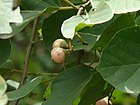Note: This is a project under development. The articles on this wiki are just being initiated and broadly incomplete. You can Help creating new pages.
Difference between revisions of "Cordia dichotoma - Uddalaka"
(→Chemical Composition) |
(→External Links) |
||
| Line 91: | Line 91: | ||
==External Links== | ==External Links== | ||
| − | * http://tropical.theferns.info/viewtropical.php?id=Cordia+dichotoma | + | * [http://tropical.theferns.info/viewtropical.php?id=Cordia+dichotoma Cordia dichotoma on theferns.info] |
| − | * https://www.bimbima.com/herbs/lasora-cordia-dichotoma-medicinal-used-and-health-benefits/11/ | + | * [https://www.bimbima.com/herbs/lasora-cordia-dichotoma-medicinal-used-and-health-benefits/11/ Cordia dichotoma on bimbima.com] |
[[Category:Herbs]] | [[Category:Herbs]] | ||
[[Category:Tree]] | [[Category:Tree]] | ||
[[Category:Boraginaceae]] | [[Category:Boraginaceae]] | ||
Revision as of 14:51, 18 April 2020
Uddalaka is a moderate sized decidious tree with big oval leaves and rooping branches. The fruits are very sticky and mucilaginous and are edible.
Contents
- 1 Uses
- 2 Parts Used
- 3 Chemical Composition
- 4 Common names
- 5 Properties
- 6 Habit
- 7 Identification
- 8 List of Ayurvedic medicine in which the herb is used
- 9 Where to get the saplings
- 10 Mode of Propagation
- 11 How to plant/cultivate
- 12 Commonly seen growing in areas
- 13 Photo Gallery
- 14 References
- 15 External Links
Uses
Wounds, Diarrhea, Irritable Bowel Syndrome, Burning sensation, Indigestion [1]
Parts Used
Chemical Composition
The fruits contain Ca 55, P 275, Zn 2, Fe 6, Mn 2, Cr 0.2 and Cu 1.6 mg/100 g (Chromium is of therapeutic value in diabetes). Antinutritional factors are—phytic acid 355, phytate phosphorus 100 and oxalic acid 250 mg/100 g.
Common names
| Language | Common name |
|---|---|
| Kannada | Challe, Challe hannu |
| Hindi | Lasora, Bada Goonda |
| Malayalam | Naruvari, Naruveli |
| Tamil | Cavarittakikam, Jollai |
| Telugu | Bankanakkera, Bankiriki |
| Marathi | NA |
| Gujarathi | NA |
| Punjabi | NA |
| Kashmiri | NA |
| Sanskrit | Bahuvarah, Bauvaraca |
| English |
Properties
Reference: Dravya - Substance, Rasa - Taste, Guna - Qualities, Veerya - Potency, Vipaka - Post-digesion effect, Karma - Pharmacological activity, Prabhava - Therepeutics.
Dravya
Rasa
Tikta (Bitter), Kashaya (Astringent)
Guna
Snigdha (Slimy), Guru (Heavy)
Veerya
Sheeta (cold)
Vipaka
Karma
Pitta, Vata, Kapha
Prabhava
Habit
Identification
Leaf
| Kind | Shape | Feature |
|---|---|---|
| Simple | Alternate | Leaves simple, entire and slightly dentate, elliptical-lanceolate to broad ovate with a round and cordate base. Variable in size and shape |
Flower
| Type | Size | Color and composition | Stamen | More information |
|---|---|---|---|---|
| Polygamous | Axillary or terminal in corymbose panicles | White to cream | 5 | Calyx 6mm long, ribbed, lobes 5, dentate ,not recurved, corolla 8mm aross, lobes 5, recurved. |
Fruit
| Type | Size | Mass | Appearance | Seeds | More information |
|---|---|---|---|---|---|
| A drupe | Ovoid, cream coloured, mucilaginous, supported by accrescent calyx | Seeds solitary | {{{6}}} |
Other features
List of Ayurvedic medicine in which the herb is used
Where to get the saplings
Mode of Propagation
How to plant/cultivate
Season to grow
Soil type
Propagation
Commonly seen growing in areas
Photo Gallery
References
External Links
- Ayurvedic Herbs known to be helpful to treat Wounds
- Ayurvedic Herbs known to be helpful to treat Diarrhea
- Ayurvedic Herbs known to be helpful to treat Irritable Bowel Syndrome
- Ayurvedic Herbs known to be helpful to treat Burning sensation
- Ayurvedic Herbs known to be helpful to treat Indigestion
- Herbs with Bark used in medicine
- Herbs with Fruits used in medicine
- Herbs with common name in Kannada
- Herbs with common name in Hindi
- Herbs with common name in Malayalam
- Herbs with common name in Tamil
- Herbs with common name in Telugu
- Herbs with common name in Sanskrit
- Habit - Tree
- Index of Plants which can be propagated by Seeds
- Herbs that are commonly seen in the region of Tropical area
- Herbs
- Tree
- Boraginaceae





